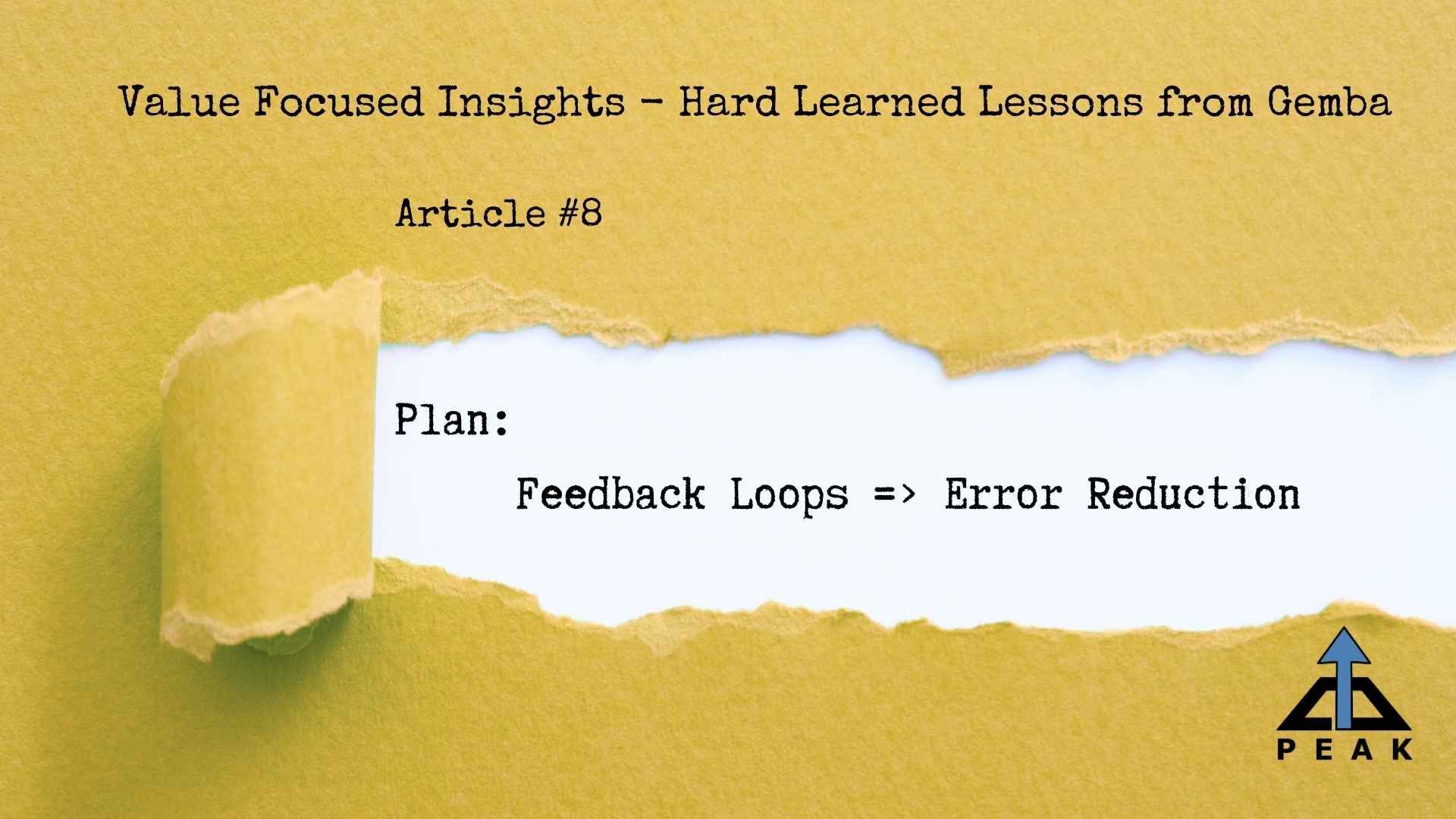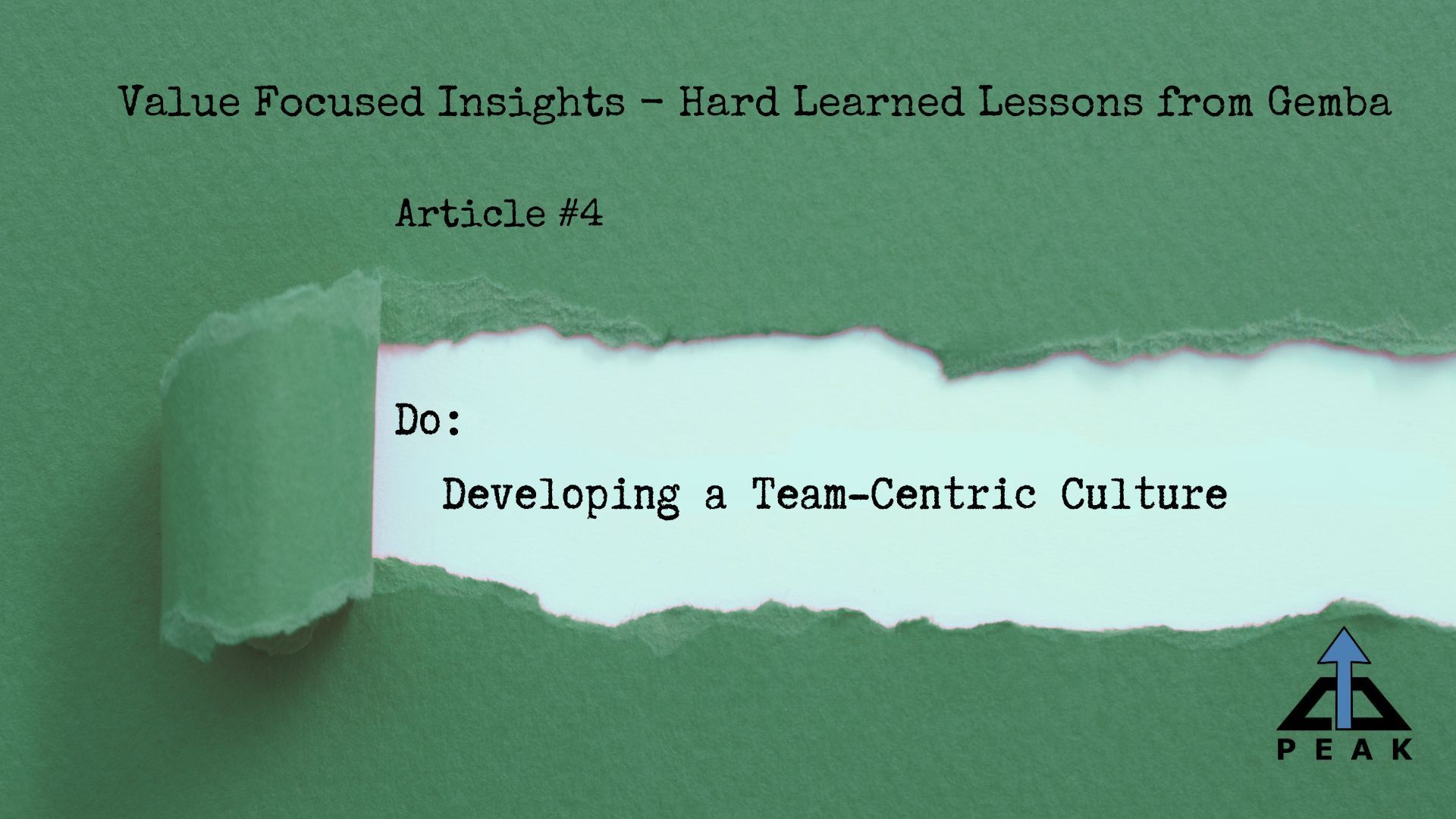Embracing Slower Times - Part 4: Right Sized Problem-Solving Tools
Tim Upchurch
This article is part 4 in our series on how to build resilience for long-term success during periods of lower demand. In this issue, we will address some ideas on how to effectively incorporate hourly personnel to support your ongoing problem-solving efforts. Their insight and expertise can generate significant long-term value if directed appropriately.
For previous articles in the series, please visit our blog page or company LinkedIn page. As always, we’d love to hear your feedback.

Success in business is heavily influenced by market conditions and effective problem-solving capabilities. Hoping for good fortune is not an effective strategy. Market conditions will heavily influence what opportunities present themselves and what solutions are available and achievable. However, you always control the timing of your actions – what you do and when. When the market declines, you have a choice. You can use any excess capacity to generate long-term VALUE or cut headcount for short term cashflow.
How to effectively deploy any extra intellectual capital will depend on your overall strategy. Good tools to develop a comprehensive understanding of opportunities are Value Stream Maps or Strategic A3’s. Details on how to develop organizational-wide strategies will be presented in a future article in this series.
To address specific problems, there are many effective problem-solving methods available. They range from very simple to extremely complicated based on the type and difficulty of the problem. We will focus this article on the types of problem-solving methods that can be deployed to support the different improvement teams discussed in our initial article:
- Safety Team - Safety Upgrades and Programs
- Uptime Team - TPM / Reliability Efforts
- Quality Team - Quality Improvements / Defect Reduction
- Productivity Team - Lean / Waste Reduction Initiatives
- Project Team - Six Sigma/Lean Sigma Project Support
It is crucial that any tools employed for the short term can be easily learned and adopted by the team members. Rapid training and onboarding are essential to ensure that individuals can quickly grasp the problem-solving techniques to efficiently contribute to the team's effort. Each team should be led by a competent expert in both relevant improvement methods and facilitation skillsets.
As the teams learn how to resolve issues, they should report their findings to management. It’s important for you to participate and listen to their stories. Support their efforts and encourage them but hold them to a standard. If you aren’t getting results, don’t hesitate to get involved and understand gaps. Make changes to team rosters, direction, or leadership if necessary. They will respond to clear direction with results.
Successful problem solving is the ability to face the facts objectively, tackle challenges head-on and develop innovative solutions. Problem solving is a skill, but it is also a process. It requires discipline and humility.
I was taught to define a problem as simply any difference between what is expected and what occurs. A process is fundamentally a hypothesis – when you execute it, you have an expected outcome.
- If the result is what you expected, then there is NO problem.
- If you get a different result than you expected, then there IS a problem/opportunity.
This simplified definition is very useful in business, and we can apply it to every single process, every single cycle. We test our hypothesis by performing the process and we get a result. If we don’t get exactly what we expected, we need to figure out why.
Your process needs to be stable and repeatable to achieve your hypothesis consistently. If you don’t have good standards built for your process and stable systems supporting it, then any idea of repeatability is just a hope. The foundation of both stability and improvement is good standard work.
Most of you will be familiar with what I’ve just described as the PDCA cycle, which stands for PLAN, DO, CHECK, ACT. Continuous improvement is simply the PDCA cycle done repeatedly - discovering a series of problems, solving them, and updating the standards as you learn. This is known as the PDCA/SDCA cycle – where the S is for Standardizing or updating the standard work. As you learn, you should improve your process either by being more productive or improving your predictability. Following the PDCA/SDCA cycle can generate significant improvements over time. It is the foundation of many of the problem-solving methods we will discuss.
Before you break everyone into their individual teams, we recommend some basic classroom training in problem-solving principles. It does not need to be extensive, but certainly should cover the framework with a few group exercises on the shop floor to gain confidence. Outline the investment the organization is making and then present them with the business challenges. Talk about how they can leverage their expertise and newfound skills to achieve the team goals. Show confidence in them and it will be returned.
Before you begin improvement work, you should already have good defined standardized work for your processes. This should also be created for standard maintenance and common repair work. A best practice is to also have written procedures on troubleshooting, and control charts established with pre-determined reaction plans to recover from common abnormal events.
If you don’t have these in place – use any additional personnel to support a standardization initiative.
Safety Upgrades and Programs
The normal plant safety organization should already have identified potential hazards. They typically utilize various data sources, such as incident reports, near-miss data, and safety audits, to identify patterns, root causes, and areas for improvement. Common safety methods such as Hazard Analysis and Critical Control Points (HACCP), Failure Modes and Effects Analysis (FMEA), and Job Safety Analysis (JSA) can be employed to assess risks, prioritize safety improvements, and implement preventive measures.
These are very important data sources and can provide good initial understanding of where problems occur or have the potential to. You might be tempted to start with this data and begin analyzing – but this might only muddy the waters. Data is only a reflection of what is happening. To get to a full understanding the team should go and see at gemba, which is the “actual place where value happens”.
The Safety Team will be made up of experts in performing the existing standard work. Have them observe work cycles for variation. This will require training to compare what they see against what is written in the standard work. Have them draw out their observations – show what problem is creating variation and why. Don’t worry about skill here, it’s about creating a simple storyboard. Work that is hard to perform by its very nature contains ergonomic or other safety risks. This leads to the work being done differently and creates noise in your process which shows up as safety, quality, and productivity problems.
If they have clearly captured and drawn the current condition, it will reveal what is happening and how it leads to variation. Any simple problem-solving tool such as brainstorming or 5 why analysis can then be used to generate acceptable solutions. Your team should use a before/after drawing to communicate what was found and what they recommend changing. They should then work with the production operators to implement and test. Afterwards, these simple drawings can be used to communicate across the organization to leverage the learnings of the team.
TPM / Reliability Efforts
There should already be a TPM/Reliability team in place that leverages downtime of equipment and equipment failures as opportunities for problem-solving. Their goals should be to minimize unplanned disruptions and increase operational efficiency.
However, most attempts to match downtime information between production groups and the maintenance department fails for a variety of reasons. This can be problematic for short term initiatives and leads to heated debates about what issues are really occurring, who is to blame and how it’s the other guy that needs to change their ways. It is recommended that you avoid this distraction and start the Uptime Team focused on a single metric for simplicity – reduce the number of service calls. An experienced and designated maintenance trainer should be assigned to the team as a bridge between the functional members.
There are two main reasons for service calls – either equipment issues or training gaps. If there are persistent issues with equipment, then events should occur normally for similar processes. If repaired correctly, equipment should run for a normal time until the next failure. If this is not the case, there are underlying issues. Good metrics to review are the frequency of the major downtime issues, the time to restore/recover and the number of repeated calls in a period (first pass yield for repair).
Have the team participate in a discussion of this prepared data analysis and ask what the data is telling them about variations of downtime events:
- When is it going down?
- What is the frequency?
- What repeat failures are occurring and when?
You will probably see spikes or trends show up. These are where the opportunities can be found and addressed. Have team members observe downtime events and repairs for the top issues. They should be checking and searching for variations from the standard work and/or troubleshooting guides – both by maintenance personnel and the operators on the line.
Use drawings to clearly document any deviations from standard and develop countermeasures or solutions to those variations. It is not uncommon to be able to significantly reduce both the frequency and impact of top downtime events through simply adherence to or slight improvements in standard work and troubleshooting guides. The work by this team will also create better long-term working relationships between the departments.
Quality / Defect Reduction
For the Quality Team, problem-solving revolves around addressing defects, yield losses, rework, and scrap. By closely examining these quality indicators, they can uncover errors or failures in stability within processes. Through techniques such as root cause analysis, statistical process control, and error-proofing methodologies, the Quality Team can identify areas for improvement, implement corrective actions, and drive continuous quality enhancement.
Observations with before/after pictures are once again a great tool to correct for variation from standards. This process should be done at the start of the initiative to identify and correct any simple issues due to weaknesses in the process. Refer to the Safety Team for details on how to conduct.
One of the simpler quality tools the team can use is a tin-soldier inspection process after each benchmark. This is a fast tool for finding where variation is occurring. By looking at differences in quality across a spectrum of products, you can easily identify variation between runs or individual parts. This is one technique where the Quality Team members can probably quickly pin-point to where variation is happening in your process and start problem solving.
They can also provide key support to initiatives as part of your broader quality strategy. Some activities their expertise can offer help are:
- Creating Control Charts and Limits
- Developing pre-determined reaction plans for out-of-control conditions
- Standardizing setpoints for Process Control Process Discipline (PCPD) Initiatives
For more difficult quality or process issues, a stronger tool is often needed to get to the root cause. My favorite tool is a modified funnel approach. I have been working and refining this method over the last 25 years. In essence, it is the standard funnel approach, but each of the components has a detailed definition that must be satisfied before moving to the next step. The tollgates for this process are common: Initial Problem Perception, Real Problem, Point of Cause, Direct Cause and Root Cause. I have found this process can normally be used to effectively solve 95% of simple quality and production issues.
Lean and Productivity Initiatives
The Productivity Team focuses on problem-solving to optimize work processes and meet standard performance levels. They monitor indicators of variation, such as deviations from standard cycle times or output levels, to identify potential problems or areas of improvement. Utilizing tools like process mapping, value stream analysis, and work measurement techniques, the Productivity team can streamline workflows, eliminate bottlenecks, and enhance overall productivity and efficiency.
Once again, the simplest tool to deploy for your Productivity Team is the before/after drawing. Most organizations have a simple kaizen form that can be used with such drawings. If not, there are many good examples to develop your own that are available online.
If you have larger or more complex problems, using A3 thinking is one of the better methods. You can use parent A3’s for larger problems to develop the higher-level opportunities, then use child A3’s for the individual leverage points. The single page format of the A3 assists by demanding good clarity in your problem understanding, as well as providing an excellent tool for communication and deploying the lessons learned.
Depending on the type of value your organization generates, another option might be to focus on reducing changeover and setup times as part of a larger SMED initiative. These are excellent problem-solving activities that will pay handsome returns in the long run.
There is no shortage of books and training on these tools. If you have a good lean team, they should already be deployed or available.
Six Sigma/Lean Sigma Project Support
Project Teams working in collaboration with engineers or other professional groups will employ more complex data analysis and problem-solving tools. Operators should always be included in these efforts, not only for their insight, but also as internal customers for any improvements. Such teams will employ statistical techniques with certified belts directing the work, under the framework of Six Sigma, Lean Six Sigma, or other improvement methods. Projects using these advanced toolsets are normally formed to address specific technical challenges, drive innovation, or achieve breakthrough improvements. Training for specific tools used by the team should be performed as part of each specific activity.
Conclusion
Problem solving lies at the core of business success. While luck and randomness may occasionally play a role, it is the ability of your organization to effectively tackle challenges that drives sustained growth and resilience. By leveraging your internal experts and right sizing your problem-solving activities you will engage your workforce, create a learning organization, and develop a lasting competitive edge in the market. When the market slowdown ends, your supercharged team will now “print” money!
At Peak Productivity, we recognize the importance of problem solving in achieving organizational success. Our consulting services are designed to help businesses optimize their problem-solving processes, implement effective methodologies, and foster a culture of continuous improvement. Together, let's unlock the power of problem solving and drive your business towards greater heights of success.
Peaks and Valleys.....












